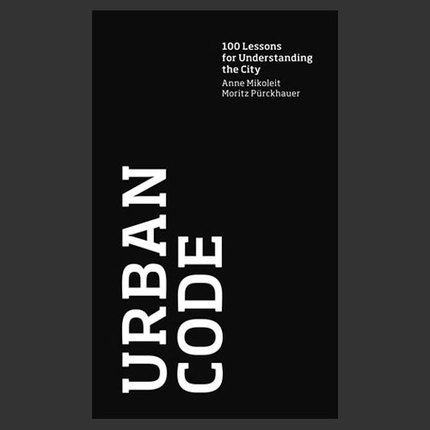
Cover of 100 Lessons for Understanding the City by Anne Mikoleit & Moritz Purckhauer
We were struck by the Table of Contents of this new title, Urban Code: 100 Lessons for Understanding the City. It reads like a staccato narrative of citylife — almost photographic in painting visual snapshots that add up to something larger.
Preface
01 People walk in the sunshine.
02 Street vendors are positioned according to the path of the sun.
03 Street vendors facilitate pedestrian movement.
04 Safe surroundings increase profits.
05 High turnover makes up for high rent.
06 Rents rise with increasing pedestrian density.
07 Global shops sell their wares on popular streets.
08 Salespeople possess analytical knowledge of the district.
09 Passersby have an intuitive knowledge of the district.
10 Familiar chain stores are landmarks.
11 Brand names attract people. People attract brand names.
12 Shops attract other shops.
13 Tourists carry bags.
14 Shops give away bags.
15 Street vendors complement the surrounding selection of shops.
16 Human traffic complies with shop opening times.
17 Street vendors reinforce fluctuations.
18 People attract people.
19 Places of concentration depend on places of emptiness.
20 Cars can park in niches.
21 Cars park on top of one another.
22 Street vendors follow wrecking balls.
23 Constant grids afford manifold patterns of movement.
24 Equal grids provoke unequal blocks.
25 Buildings outlive uses.
26 A block consists of many buildings.
27 Each building has at least one entrance.
28 No entrance is the same as any other entrance.
29 Entrances are meeting points.
30 Entrances are hurdles.
31 Shops attract pedestrians into the depths of the block.
32 Each building houses a business.
33 Small, specialized shops are essential to maintaining a district’s vitality.
34 Display windows are mirrors.
35 Pedestrians are potential buyers.
36 Pedestrians walk on sidewalks.
37 The sidewalk is a cellar entrance.
38 Wares are stored in the cellar.
39 Deliveries are limited to the early hours of the morning.
40 Delivery vans block the streets.
41 Locals and tourists use the streets at different times.
42 People walk more slowly in the afternoon.
43 Rituals result from parallel working hours.
44 The day to day happens on the street.
45 Workers wear work clothes.
46 Taxi drivers live on the street.
47 Locals have dogs.
48 Every thirtieth pedestrian has gray hair.
49 Old people sit on benches.
50 Benches are found on public squares.
51 Playgrounds draw children in.
52 Not every playground is a playground.
53 Fathers meet fathers on playgrounds.
54 Small public squares are busier than large public squares.
55 Crossroads are public squares.
56 People wait at crossroads.
57 Hot dog stands are at crossroads.
58 Snack stands smell of food.
59 Shops lead people.
60 Shops are new, houses are old.
61 Shop owners put their trash bags out on the street.
62 A city is made up of characteristic parts.
63 Streets were once communal spaces.
64 Public squares and niches create positive outside spaces.
65 People sit with their back protected.
66 Sitting people observe their environment.
67 Pedestrians lost in thought are not lost.
68 Tourists stand still. Residents pass.
69 When people stand still, groups develop.
70 Groups attract people.
71 Street performers animate public spaces.
72 Groups walk more slowly than individuals.
73 Nightlife hotspots increase pedestrian traffic.
74 People are afraid of the dark.
75 Many lights illuminate the night.
76 Street cafés lie at the center of events.
77 Subway stations thicken pedestrian traffic.
78 Narrow streets carry many pedestrians.
79 Narrow streets carry little traffic.
80 Cobblestones tell stories.
81 Local streets are one-way streets.
82 Cars drive down main roads faster than down side streets.
83 Pedestrians walk on a red signal, if traffic is slow.
84 Traffic jams tend to bring out aggression.
85 Weeds reduce aggression.
86 The counterpart to the urban everyday is the urban park.
87 People who walk have a destination in mind.
88 Good walkways have a good range of destinations along them.
89 Destinations are more attractive when they invite a stay.
90 Grocery stores are important local destinations.
91 Grocery stores on street corners have an advantage.
92 The livelihood of a street begins at crossroads.
93 SoHo life begins with traffic lights.
94 Traffic lights create traffic noise.
95 People wait for taxis. Taxis wait for people.
96 Taxis compensate for public transportation.
97 Subway stations are at borders.
98 A neighborhood has borders.
99 Through streets are borders.
100 Fractures create friction.
Epilogue
